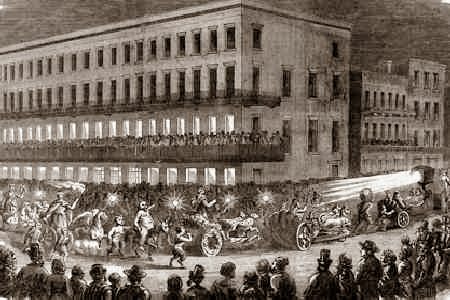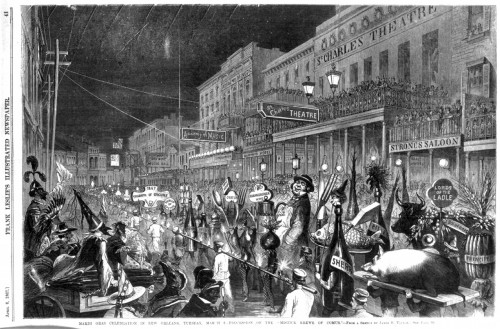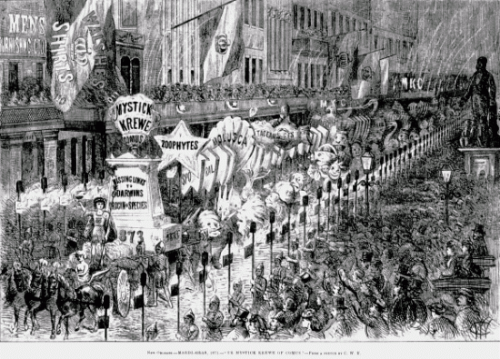New Orleans has been celebrating Mardi Gras since the 1730s, but it took a hundred years before we began to see street processions. The first processions included carriages and maskers on horseback. The first floats appeared in 1856 with the formation of the first Mardi Gras krewe: the Mistick Krewe of Comus.
Enslaved and free men of color lit the spectacles with torches. They were called the flambeaux. Eventually, they became a spectacle in themselves, dancing for tips. In the historical engravings below from the 1850s, you can see men carrying torches among the festivities (Wikimedia Commons and the Library of Congress).



Today, there are still flambeaux carriers and they are still mostly black men. The tradition has been passed down through generations. In a video at nola.com, a flambeaux carrier named Herbert Long explains that he’s been carrying flame for 18 years, following “generations of [his] family.” Today they carry kerosene torches.

Unbelievably, the first white men to carry the flambeaux appeared in a parade in 1969, something I’ll talk about tomorrow. Meanwhile, the first ever all-female flambeaux troupe, the glambeaux, debuted in 2014.

Today, the flambeaux are a beloved part of the Mardi Gras tradition, good and bad.
Lisa Wade, PhD is an Associate Professor at Tulane University. She is the author of American Hookup, a book about college sexual culture; a textbook about gender; and a forthcoming introductory text: Terrible Magnificent Sociology. You can follow her on Twitter and Instagram.
Comments 27
Mels — February 16, 2015
The image links in the middle set are all messed up; three of them show the same picture when enlarged.
Elena — February 17, 2015
"Enslaved and free men of color lit the spectacles with torches. They were called the [standard French word for "torches"]"
Why Are There So Many Mardi Gras Parades? | A Nerd's Guide to New Orleans — February 18, 2015
[…] The Krewe of Tucks was started by two white male Loyola students in 1969. They wanted to parade as flambeaux carriers — a nod to the original form of parades in which slaves or free men of color carried flames […]
Reamer Manuel — November 30, 2021
I admire your tremendous help that is quite updated to all and hope after getting the material on your blog we are able to explore. Thumbs up with dissertation literature review services work from the history truly like to grab the history update please continue sharing more.
googl — March 27, 2022
law dissertation writing service
Daniel Lisa — May 25, 2022
Thanks for your effort and for writing the content with pictures accordingly. Keep up writing the excellent content with dissertation proofreading services for the users to get help.
James Jordan — July 25, 2023
I am especially interested in how flambeaux started as a practical way to light up the night parades, but also reflected the racial and social issues of the time.
Best Home Remodeling Services Barrington IL
Maria Ward — February 25, 2024
I recently used Pangea Global Support for translation services, and I'm thoroughly impressed. Their team exhibited unmatched professionalism and attention to detail. The translations were not only accurate but culturally appropriate. The support team was responsive and went above and beyond to ensure my satisfaction. Pangea's versatility in handling diverse projects makes them my go-to for translation needs. Highly recommend https://www.pangea.global/game-localization-sevices/!
Robort 125 — May 24, 2024
These sensors detect changes in infrared radiation, which is emitted by all objects with a temperature above absolute zero. When someone enters a room, their body heat will cause a change in the infrared radiation levels, which the PIR sensor will detect and trigger the alarm. fire alarm repair in Raleigh
Kamis — May 28, 2025
Start your journey to become a drift boss now!
backlinks — October 29, 2025
fananas for seo and backlinks
Fananas specializes in high-quality backlinks, enhancing online visibility and driving organic traffic. Our tailored strategies build authority while ensuring compliance with Google's best practices for lasting results.
باك لينك
elmoalem — October 29, 2025
شراء المطابخ المستعملة بالرياض أصبح اليوم أسهل بكثير بفضل شركة المعلم التي توفر خدمات شراء المطابخ القديمة بأسعار مناسبة وجودة مضمونة، الشركة تمنح أصحاب المطابخ فرصة ممتازة للاستفادة من مطابخهم القديمة بدلًا من التخلص منها دون مقابل فهي تقوم بتقييم االمطبخ بدقة لضمان أن يحصل كل عميل على السعر العادل الذي يستحقه.
aly alaa — November 24, 2025
نقل العفش ليس مجرد عملية لوجستية، بل انتقال لحياة جديدة مليئة بالبركة والسكينة في المدينة المقدسة. وفي عالم شركات نقل العفش، تبرز شركة النقل السريع افضل شركة نقل عفش كالخيار الأمثل بفضل خدماتها المتكاملة والاحترافية: أسطول سيارات مجهز على أعلى مستوى، فك وتركيب بعناية فائقة، تخزين آمن، وأدوات متقدمة مثل سيارة نقل العفش وونش رفع العفش الي مكة. نحن نعامل أثاثكم كجزء من عائلتنا، نضمن سلامته وراحتكم في كل خطوة.
اختيار أفضل شركة نقل عفش يعني اختيار الثقة والاحترافية السعودية الأصيلة. مع شركة النقل السريع، انتقالكم سيكون سلساً وخالياً من الهموم. إذا كنتم جاهزين لبداية جديدة، تواصلوا معنا الآن على واتساب: 0555096376 - هاتف: 0533400538، ودعونا نكون جزءاً من قصتكم. شكراً لثقتكم، ونتمنى لكم انتقالاً موفقاً مليئاً بالخير والبركة في أفضل شركة نقل عفش.
www.alaistul.com
مجموعة التألق — December 13, 2025
في "مجموعة التألق"، نتخصص في انشاء مسابح بجدة بتقنيات ذكية تضمن لكم أقل تكاليف وأعلى متعة. تواصلوا معنا لتحويل حديقتكم إلى واقع.
مجموعة التألق — December 13, 2025
هل مسبحكم قديم ويحتاج لتجديد؟ في "مجموعة التألق" نقدم خدمة ترميم مسابح بجدة تعيده جديداً باستخدام أقوى مواد العزل الحديثة، مع ضمان كامل على العمل. لا تهملوا مسبحكم.
مجموعة التألق — December 13, 2025
تصاميم رائعة حقاً! فريقنا في "مجموعة التألق" يبدع في تصميم مسابح بجدة لتحويل حديقتكم إلى منتجع خاص. نصمم بأسلوب عصري يجمع بين الفخامة والوظيفة. استمتعوا بالصيف القادم في مسبح من تصميمنا.
مجموعة التألق — December 13, 2025
إذا كنتم تبحثون عن مقاول مسابح بجدة يجمع بين الخبرة والضمان الحقيقي، فإن "مجموعة التألق" هي خياركم الأمثل. شاهدوا مشاريعنا وتأكدوا بأنفسكم من جودة عملنا.
مجموعة التألق — December 13, 2025
في "مجموعة التألق"، نضمن لكم بناء مسابح بجدة بهيكل خرساني معزول بأحدث التقنيات ليدوم مدى الحياة. الجودة هي توقيعنا في كل مشروع.
Schlüsseldienst Köln — December 15, 2025
Wer in der Rheinmetropole vor verschlossener Tür steht, benötigt einen Partner, dem er vertrauen kann. Transparenz bei den Anfahrtskosten und verbindliche Festpreise sind die Qualitätsmerkmale, auf die Sie achten sollten. Ein seriöser schlüsseldienst köln ist in der Regel innerhalb von 15 bis 30 Minuten in allen Veedeln vor Ort, um Ihnen schnell und kompetent weiterzuhelfen, ohne dabei unnötige Kosten zu verursachen.
انشاء مسابح بمكة — December 16, 2025
تنفيذ المسابح في بيئة مكة ذات التضاريس الصخرية يتطلب خبرة هندسية استثنائية لضمان الاستقرار والمتانة. تقدم “مجموعة التألق” حلولاً مبتكرة وشاملة في مجال انشاء مسابح بمكة، حيث نراعي أدق التفاصيل من مرحلة الحفر وتأسيس الحديد وحتى التشطيب النهائي، مستخدمين أفضل المواد المقاومة للتغيرات المناخية لضمان مسبح فاخر وآمن يدوم لسنوات طويلة.
الاسكا — December 18, 2025
في إمارة عجمان، يبحث السكان دائماً عن خدمات صيانة موثوقة تستجيب لحالات الطوارئ بسرعة. تتميز "الاسكا" بكونها شركة تسليك مجاري في عجمان تقدم حلولاً شاملة لفتح البالوعات المسدودة وتنظيف غرف التفتيش بأحدث سيارات الشفط (الفاكيوم)، مع ضمان القضاء على أسباب الانسداد المتكررة وحماية البنية التحتية لمنزلك من التآكل.
الاسكا — December 18, 2025
للحفاظ على بيئة صحية ونظيفة في منزلك بالشارقة، لا بد من الصيانة الدورية لشبكات الصرف. تقدم "الاسكا" خدماتها الرائدة بصفتها شركة تسليك مجاري في الشارقة متخصصة في معالجة انسدادات المطابخ والحمامات بدقة عالية، مستخدمة أجهزة الكشف الحديثة لتحديد مكان الخلل وإصلاحه دون الحاجة لتكسير الأرضيات أو إتلاف الديكورات.
الاسكا — December 18, 2025
تعتبر مشاكل الصرف الصحي من أكثر التحديات المزعجة التي تواجه العقارات في مدينة دبي النابضة بالحياة. لضمان حل جذري وسريع، تعتمد "الاسكا" كأفضل شركة تسليك مجاري في دبي على تقنيات ضغط المياه والنيتروجين لتفتيت الدهون والرواسب الصلبة في الأنابيب، مما يعيد تدفق المياه لطبيعته فوراً ويجنبك مخاطر طفح المجاري والروائح الكريهة.
الفردوس للسباكة — December 20, 2025
تعاني الكثير من المنازل في مناطق الكويت المختلفة من انسدادات متكررة بسبب الترسبات الدهنية والشوائب الصلبة. تقدم شركة "الفردوس" حلولاً جذرية عبر خدمة تسليك مجاري بالكويت باستخدام أحدث ماكينات الضغط العالي والسبرنج، مما يضمن تنظيفاً عميقاً للمناهيل والبيارات والقضاء على الروائح الكريهة نهائياً بأيدي فنيين محترفين.
الفردوس للسباكة — December 20, 2025
عند حدوث طفح مفاجئ في الصرف الصحي، لا بد من الاستعانة بخبرة متخصصة لتدارك الموقف قبل تفاقم الأضرار. توفر شركة "الفردوس" أمهر فني تسليك مجاري مجهز بأحدث المعدات للكشف عن أماكن الانسداد بدقة ومعالجتها فوراً، سواء في المطابخ أو الحمامات، مع ضمان سرعة الاستجابة لخدمة جميع مناطق الكويت على مدار الساعة.
الفردوس للسباكة — December 20, 2025
تتطلب أعمال التمديدات الصحية وصيانة الأدوات الصحية دقة عالية لضمان عدم حدوث تسربات مستقبلية. يعتمد عملاء "الفردوس" على خبرة أفضل سباك صحي يقوم بتركيب وصيانة المضخات، السخانات، والخلاطات بمهارة فائقة، موفراً خدمات تأسيس وتشطيب السباكة للمباني الجديدة والقديمة بأعلى معايير الجودة والمصداقية.
الفردوس للسباكة — December 20, 2025
التهوية الجيدة هي أساس البيت الصحي الخالي من الرطوبة والروائح غير المرغوبة، خاصة في المطابخ والحمامات المغلقة. تقدم شركة "الفردوس" خدمة متخصصة في تركيب شفاطات مركزية وعادية من أفضل الماركات العالمية، حيث يقوم الفنيون باختيار الموقع الأنسب للشفاط لضمان أعلى كفاءة في سحب الهواء وتجديده داخل المنزل.